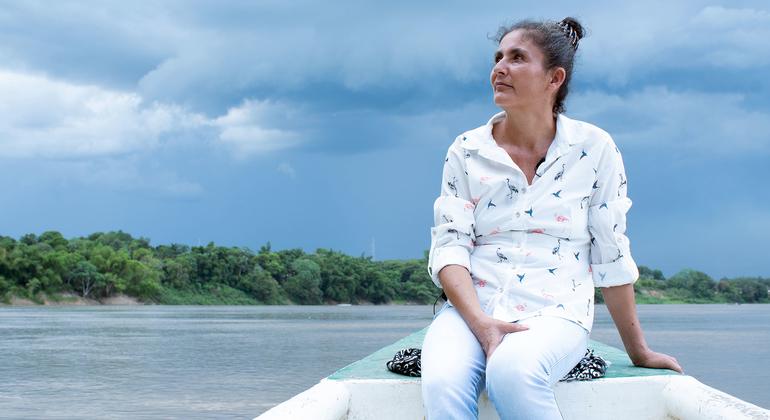Colombian conflict survivors become jungle heroes in search of climate change solutions

This waterway, a silent witness to the chaos of the Mapiripán urban area, has seen it all – wildlife trafficking, conflict-fueled coca harvests, human bodies dumped left behind in the midst of a horrific massacre and the relentless erosion of the rainforest it once nourished.
Now, Sandra hopes it will erase the pain of the past and usher in an era of healing for her community and for her land.
Mapiripán has long been trapped in a cycle of conflict and environmental degradation exacerbated by climate change. Years ago, it was famous for its illegal wild fur trade; Later, this place became a coca growing area, attracting armed groups to turn the lush tropical forest into a battlefield.
Promise of prosperity
Young Sandra, facing extreme poverty and violence, came to Mapiripán in the early 2000s, lured by the promise of prosperity. “There was an economic boom, but it came from illegal farming – there was no other way to live,” she recalls.
But the region’s prosperity was short-lived. Eventually, the conflict escalated and the coca trade collapsed, leaving the community devastated. “We live between prosperity and conflict,” Sandra said, her voice shaking as she recounted her harrowing experiences of hiding from armed groups.
By 2009, most people in rural communities in the region were forced to leave.
Many, including Sandra, returned after the signing of the Colombian Peace Agreement in 2016, which ended a decades-long insurgency.
But lands damaged by conflict and unsustainable farming now struggle to produce. Due to lack of infrastructure and limited access to markets, farmers like Marco Antonio Lopez have turned to livestock farming to survive.
Explosion of deforestation
This means more deforestation. “We will personally deforest 15 or 20 hectares to feed our cattle, not to destroy biodiversity but to find a way to survive,” he admitted.
They also watched helplessly as newcomers took over abandoned areas and deforested larger lands. “They don’t care about deforesting 700 to 1,000 hectares,” Sandra said with disgust. “They will cut straight through the center of the mountain.”
“That’s when we started to feel the heat, to see the climate change,” she added.

A reforestation system in the Amazon that incorporates trees and shrubs into livestock pastures. This increases carbon storage in trees and soil, reduces greenhouse gas emissions from livestock and fertilizer, and increases resilience to climate change.
Sandra and Marco now look forward to a future where they can improve their lives while protecting the forest, a desire to share across the country.
In fact, Colombia has made significant progress in curbing deforestation. The country demonstrated that, between 2015 and 2016, deforestation rates in the Amazon Biome were significantly reduced, preventing nearly seven million tons of CO2 emissions.
This success has helped the country achieve $28.2 million in Results-Based Payments (RBP) from Green Climate Fund (GCF) in 2020 to implement Colombia’s REDD+ (Reducing Emissions from Deforestation and Forest Degradation) project, known by the country as Amazonian Vision.
Led by Food and Agriculture Organization of the United Nations (FAO), Amazonian Vision promote conservation and sustainable land management in rapidly deforested areas like Mapiripán.

A reforestation system in the Amazon that incorporates trees and bushes into livestock pastures. This increases carbon storage in trees and soil, reduces greenhouse gas emissions from livestock and fertilizer, and increases resilience to climate change.
‘We, the community’
Working with the Colombian government and local communities, the FAO project runs until the end of 2026, protecting the Amazon biota through forest monitoring and sustainable management practices, benefiting midwives small producers, farmer associations and local authorities.
“We, the community, are aware of the problem caused by climate change. Now when we go to work in the fields, the sun is so intense, we can’t cope with the heat anymore. We have really started to develop an awareness of the need to preserve these beautiful ecosystems that we have on the territory,” said Marco.
“If the forest thrives and we thrive, then the animals thrive too,” Sandra added.

Deforestation releases carbon into the atmosphere, causing climate change and further harming forests.
“With this project, we are ensuring forest conservation while families generate resources through linked projects,” explains Sandra Vanegas, FAO local market coordinator.
“We are promoting agroforestry gardens where they can produce for their own consumption and conserve seeds and endemic plants.”
Indeed, Marco and Sandra’s community now has a deep understanding of agroforestry, a sustainable land use method that combines agriculture and forestry. Through educational tours, they saw firsthand how to restore soil with organic fertilizers and grow their own food.
Marco recounts the gradual awakening of their herd. “At the time, we didn’t know that we didn’t need to expand the pasture for our cows to have enough nutrition,” he admits.
He said the initiative opened their eyes through a series of training sessions. Now they have started implementing the afforestation system by planting trees on their family farm.
“They gave us a broader perspective, helping us realize the damage and consequences of continued deforestation. That’s when we, as leaders, took a stronger stance to protect the forest.”
This new awareness led them to form the AGROCIARE association to pursue sustainable projects. For example, they have actively worked to grow and commercialize the cacay tree, a native tree in the Amazon known for its nutritious fruit.
With training in legal and organizational skills, they have strengthened the association’s capacity to advocate for environmental protection and better livelihoods.
“Our vision is to ensure that our tropical forest and environmental treasures are protected by the people who live here,” Marco declared.
By working with rural communities, the program is finding climate solutions that are effective, equitable, and deliver a different future for the Amazon.
Agri-food system solutions are climate, biodiversity and soil solutions
This story is part of a three-part series from FAO on climate, biodiversity and land solutions in Colombia. These stories take you into the arid landscape of La Guajira, where the SCALA program is helping climate resilience and food securityto the Pacific coast, where a project supported by the Global Environment Facility is working to conserve rich biodiversity while contributing to the pursuit of peace.




